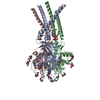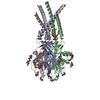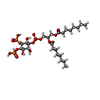+ データを開く
データを開く
- 基本情報
基本情報
| 登録情報 |  | ||||||||||||
|---|---|---|---|---|---|---|---|---|---|---|---|---|---|
| タイトル | Human PAC in nanodisc at pH 4.0 with PI(4,5)P2 diC8 | ||||||||||||
 マップデータ マップデータ | Unsharpened map of human PAC in nanodisc at pH4 with 0.5mM PI(4,5)P2 diC8. | ||||||||||||
 試料 試料 |
| ||||||||||||
 キーワード キーワード | PAC / TMEM206 / ASOR / PAORAC / ion channels / chloride channel / MEMBRANE PROTEIN | ||||||||||||
| 機能・相同性 | pH-gated chloride channel activity / TMEM206 protein / TMEM206 protein family / chloride transport / chloride channel complex / cell surface / plasma membrane / Proton-activated chloride channel 機能・相同性情報 機能・相同性情報 | ||||||||||||
| 生物種 |  Homo sapiens (ヒト) Homo sapiens (ヒト) | ||||||||||||
| 手法 | 単粒子再構成法 / クライオ電子顕微鏡法 / 解像度: 2.71 Å | ||||||||||||
 データ登録者 データ登録者 | Ruan Z / Lu W | ||||||||||||
| 資金援助 |  米国, 3件 米国, 3件
| ||||||||||||
 引用 引用 |  ジャーナル: Elife / 年: 2023 ジャーナル: Elife / 年: 2023タイトル: Inhibition of the proton-activated chloride channel PAC by PIP. 著者: Ljubica Mihaljević / Zheng Ruan / James Osei-Owusu / Wei Lü / Zhaozhu Qiu /  要旨: Proton-activated chloride (PAC) channel is a ubiquitously expressed pH-sensing ion channel, encoded by (). PAC regulates endosomal acidification and macropinosome shrinkage by releasing chloride ...Proton-activated chloride (PAC) channel is a ubiquitously expressed pH-sensing ion channel, encoded by (). PAC regulates endosomal acidification and macropinosome shrinkage by releasing chloride from the organelle lumens. It is also found at the cell surface, where it is activated under pathological conditions related to acidosis and contributes to acid-induced cell death. However, the pharmacology of the PAC channel is poorly understood. Here, we report that phosphatidylinositol (4,5)-bisphosphate (PIP) potently inhibits PAC channel activity. We solved the cryo-electron microscopy structure of PAC with PIP at pH 4.0 and identified its putative binding site, which, surprisingly, locates on the extracellular side of the transmembrane domain (TMD). While the overall conformation resembles the previously resolved PAC structure in the desensitized state, the TMD undergoes remodeling upon PIP-binding. Structural and electrophysiological analyses suggest that PIP inhibits the PAC channel by stabilizing the channel in a desensitized-like conformation. Our findings identify PIP as a new pharmacological tool for the PAC channel and lay the foundation for future drug discovery targeting this channel. | ||||||||||||
| 履歴 |
|
- 構造の表示
構造の表示
| 添付画像 |
|---|
- ダウンロードとリンク
ダウンロードとリンク
-EMDBアーカイブ
| マップデータ |  emd_28535.map.gz emd_28535.map.gz | 51.8 MB |  EMDBマップデータ形式 EMDBマップデータ形式 | |
|---|---|---|---|---|
| ヘッダ (付随情報) |  emd-28535-v30.xml emd-28535-v30.xml emd-28535.xml emd-28535.xml | 17 KB 17 KB | 表示 表示 |  EMDBヘッダ EMDBヘッダ |
| 画像 |  emd_28535.png emd_28535.png | 121.9 KB | ||
| Filedesc metadata |  emd-28535.cif.gz emd-28535.cif.gz | 5.7 KB | ||
| その他 |  emd_28535_additional_1.map.gz emd_28535_additional_1.map.gz emd_28535_half_map_1.map.gz emd_28535_half_map_1.map.gz emd_28535_half_map_2.map.gz emd_28535_half_map_2.map.gz | 96.8 MB 95.5 MB 95.4 MB | ||
| アーカイブディレクトリ |  http://ftp.pdbj.org/pub/emdb/structures/EMD-28535 http://ftp.pdbj.org/pub/emdb/structures/EMD-28535 ftp://ftp.pdbj.org/pub/emdb/structures/EMD-28535 ftp://ftp.pdbj.org/pub/emdb/structures/EMD-28535 | HTTPS FTP |
-検証レポート
| 文書・要旨 |  emd_28535_validation.pdf.gz emd_28535_validation.pdf.gz | 997.5 KB | 表示 |  EMDB検証レポート EMDB検証レポート |
|---|---|---|---|---|
| 文書・詳細版 |  emd_28535_full_validation.pdf.gz emd_28535_full_validation.pdf.gz | 997.1 KB | 表示 | |
| XML形式データ |  emd_28535_validation.xml.gz emd_28535_validation.xml.gz | 13.5 KB | 表示 | |
| CIF形式データ |  emd_28535_validation.cif.gz emd_28535_validation.cif.gz | 15.8 KB | 表示 | |
| アーカイブディレクトリ |  https://ftp.pdbj.org/pub/emdb/validation_reports/EMD-28535 https://ftp.pdbj.org/pub/emdb/validation_reports/EMD-28535 ftp://ftp.pdbj.org/pub/emdb/validation_reports/EMD-28535 ftp://ftp.pdbj.org/pub/emdb/validation_reports/EMD-28535 | HTTPS FTP |
-関連構造データ
| 関連構造データ |  8eq4MC  8fblC M: このマップから作成された原子モデル C: 同じ文献を引用 ( |
|---|---|
| 類似構造データ | 類似検索 - 機能・相同性  F&H 検索 F&H 検索 |
- リンク
リンク
| EMDBのページ |  EMDB (EBI/PDBe) / EMDB (EBI/PDBe) /  EMDataResource EMDataResource |
|---|
- マップ
マップ
| ファイル |  ダウンロード / ファイル: emd_28535.map.gz / 形式: CCP4 / 大きさ: 103 MB / タイプ: IMAGE STORED AS FLOATING POINT NUMBER (4 BYTES) ダウンロード / ファイル: emd_28535.map.gz / 形式: CCP4 / 大きさ: 103 MB / タイプ: IMAGE STORED AS FLOATING POINT NUMBER (4 BYTES) | ||||||||||||||||||||||||||||||||||||
|---|---|---|---|---|---|---|---|---|---|---|---|---|---|---|---|---|---|---|---|---|---|---|---|---|---|---|---|---|---|---|---|---|---|---|---|---|---|
| 注釈 | Unsharpened map of human PAC in nanodisc at pH4 with 0.5mM PI(4,5)P2 diC8. | ||||||||||||||||||||||||||||||||||||
| 投影像・断面図 | 画像のコントロール
画像は Spider により作成 | ||||||||||||||||||||||||||||||||||||
| ボクセルのサイズ | X=Y=Z: 0.826 Å | ||||||||||||||||||||||||||||||||||||
| 密度 |
| ||||||||||||||||||||||||||||||||||||
| 対称性 | 空間群: 1 | ||||||||||||||||||||||||||||||||||||
| 詳細 | EMDB XML:
|
-添付データ
-追加マップ: Sharpened map of human PAC in nanodisc at...
| ファイル | emd_28535_additional_1.map | ||||||||||||
|---|---|---|---|---|---|---|---|---|---|---|---|---|---|
| 注釈 | Sharpened map of human PAC in nanodisc at pH4 with 0.5mM PI(4,5)P2 diC8. | ||||||||||||
| 投影像・断面図 |
| ||||||||||||
| 密度ヒストグラム |
-ハーフマップ: #2
| ファイル | emd_28535_half_map_1.map | ||||||||||||
|---|---|---|---|---|---|---|---|---|---|---|---|---|---|
| 投影像・断面図 |
| ||||||||||||
| 密度ヒストグラム |
-ハーフマップ: #1
| ファイル | emd_28535_half_map_2.map | ||||||||||||
|---|---|---|---|---|---|---|---|---|---|---|---|---|---|
| 投影像・断面図 |
| ||||||||||||
| 密度ヒストグラム |
- 試料の構成要素
試料の構成要素
-全体 : Proton activated chloride channel at pH 4.0 with 0.5mM PIP2
| 全体 | 名称: Proton activated chloride channel at pH 4.0 with 0.5mM PIP2 |
|---|---|
| 要素 |
|
-超分子 #1: Proton activated chloride channel at pH 4.0 with 0.5mM PIP2
| 超分子 | 名称: Proton activated chloride channel at pH 4.0 with 0.5mM PIP2 タイプ: complex / ID: 1 / 親要素: 0 / 含まれる分子: #1 |
|---|---|
| 由来(天然) | 生物種:  Homo sapiens (ヒト) Homo sapiens (ヒト) |
-分子 #1: Proton-activated chloride channel
| 分子 | 名称: Proton-activated chloride channel / タイプ: protein_or_peptide / ID: 1 / コピー数: 3 / 光学異性体: LEVO |
|---|---|
| 由来(天然) | 生物種:  Homo sapiens (ヒト) Homo sapiens (ヒト) |
| 分子量 | 理論値: 40.092047 KDa |
| 組換発現 | 生物種:  Homo sapiens (ヒト) Homo sapiens (ヒト) |
| 配列 | 文字列: MIRQERSTSY QELSEELVQV VENSELADEQ DKETVRVQGP GILPGLDSES ASSSIRFSKA CLKNVFSVLL IFIYLLLMAV AVFLVYRTI TDFREKLKHP VMSVSYKEVD RYDAPGIALY PGQAQLLSCK HHYEVIPPLT SPGQPGDMNC TTQRINYTDP F SNQTVKSA ...文字列: MIRQERSTSY QELSEELVQV VENSELADEQ DKETVRVQGP GILPGLDSES ASSSIRFSKA CLKNVFSVLL IFIYLLLMAV AVFLVYRTI TDFREKLKHP VMSVSYKEVD RYDAPGIALY PGQAQLLSCK HHYEVIPPLT SPGQPGDMNC TTQRINYTDP F SNQTVKSA LIVQGPREVK KRELVFLQFR LNKSSEDFSA IDYLLFSSFQ EFLQSPNRVG FMQACESAYS SWKFSGGFRT WV KMSLVKT KEEDGREAVE FRQETSVVNY IDQRPAAKKS AQLFFVVFEW KDPFIQKVQD IVTANPWNTI ALLCGAFLAL FKA AEFAKL SIKWMIKIRK RYLKRRGQAT SHIS UniProtKB: Proton-activated chloride channel |
-分子 #2: 2-acetamido-2-deoxy-beta-D-glucopyranose
| 分子 | 名称: 2-acetamido-2-deoxy-beta-D-glucopyranose / タイプ: ligand / ID: 2 / コピー数: 12 / 式: NAG |
|---|---|
| 分子量 | 理論値: 221.208 Da |
| Chemical component information |  ChemComp-NAG: |
-分子 #3: [(2R)-2-octanoyloxy-3-[oxidanyl-[(1R,2R,3S,4R,5R,6S)-2,3,6-tris(o...
| 分子 | 名称: [(2R)-2-octanoyloxy-3-[oxidanyl-[(1R,2R,3S,4R,5R,6S)-2,3,6-tris(oxidanyl)-4,5-diphosphonooxy-cyclohexyl]oxy-phosphoryl]oxy-propyl] octanoate タイプ: ligand / ID: 3 / コピー数: 3 / 式: PIO |
|---|---|
| 分子量 | 理論値: 746.566 Da |
| Chemical component information |  ChemComp-PIO: |
-実験情報
-構造解析
| 手法 | クライオ電子顕微鏡法 |
|---|---|
 解析 解析 | 単粒子再構成法 |
| 試料の集合状態 | particle |
- 試料調製
試料調製
| 濃度 | 5 mg/mL |
|---|---|
| 緩衝液 | pH: 4 |
| 凍結 | 凍結剤: ETHANE / チャンバー内湿度: 100 % / チャンバー内温度: 291 K / 装置: FEI VITROBOT MARK IV |
- 電子顕微鏡法
電子顕微鏡法
| 顕微鏡 | FEI TITAN KRIOS |
|---|---|
| 撮影 | フィルム・検出器のモデル: GATAN K3 BIOQUANTUM (6k x 4k) 平均電子線量: 50.0 e/Å2 |
| 電子線 | 加速電圧: 300 kV / 電子線源:  FIELD EMISSION GUN FIELD EMISSION GUN |
| 電子光学系 | C2レンズ絞り径: 70.0 µm / 照射モード: FLOOD BEAM / 撮影モード: BRIGHT FIELD / Cs: 2.7 mm / 最大 デフォーカス(公称値): 24.0 µm / 最小 デフォーカス(公称値): 6.0 µm |
| 実験機器 |  モデル: Titan Krios / 画像提供: FEI Company |
- 画像解析
画像解析
| 初期モデル | モデルのタイプ: NONE |
|---|---|
| 最終 再構成 | 解像度のタイプ: BY AUTHOR / 解像度: 2.71 Å / 解像度の算出法: FSC 0.143 CUT-OFF / 使用した粒子像数: 84149 |
| 初期 角度割当 | タイプ: RANDOM ASSIGNMENT |
| 最終 角度割当 | タイプ: MAXIMUM LIKELIHOOD |
 ムービー
ムービー コントローラー
コントローラー





 Z (Sec.)
Z (Sec.) Y (Row.)
Y (Row.) X (Col.)
X (Col.)












































